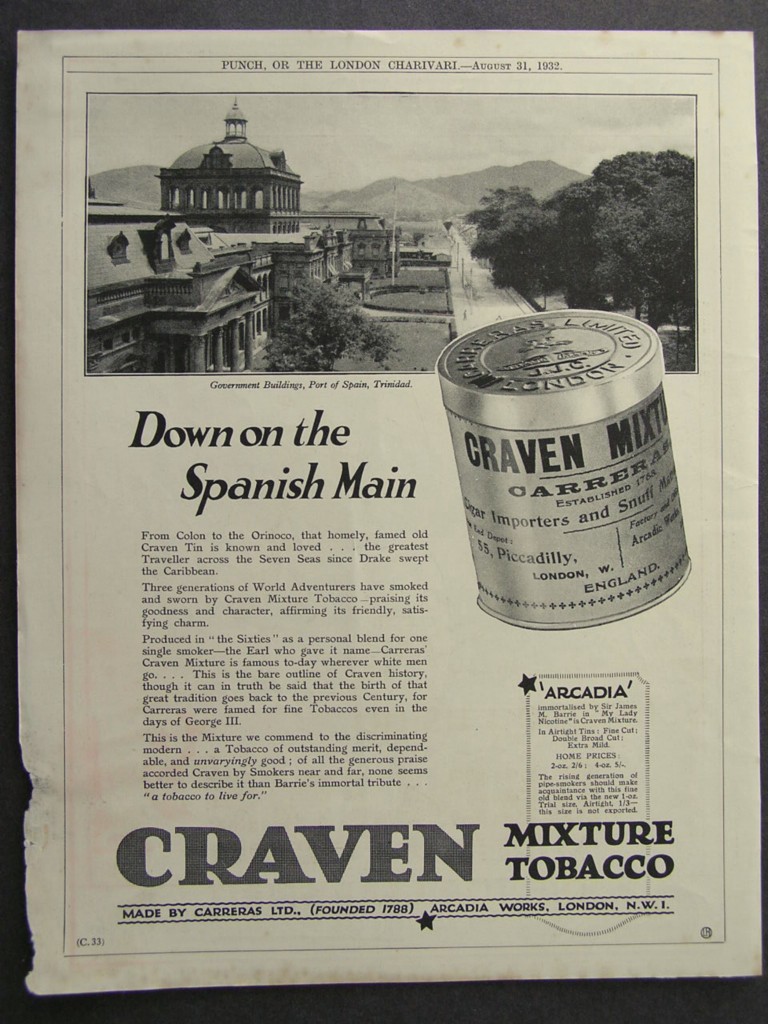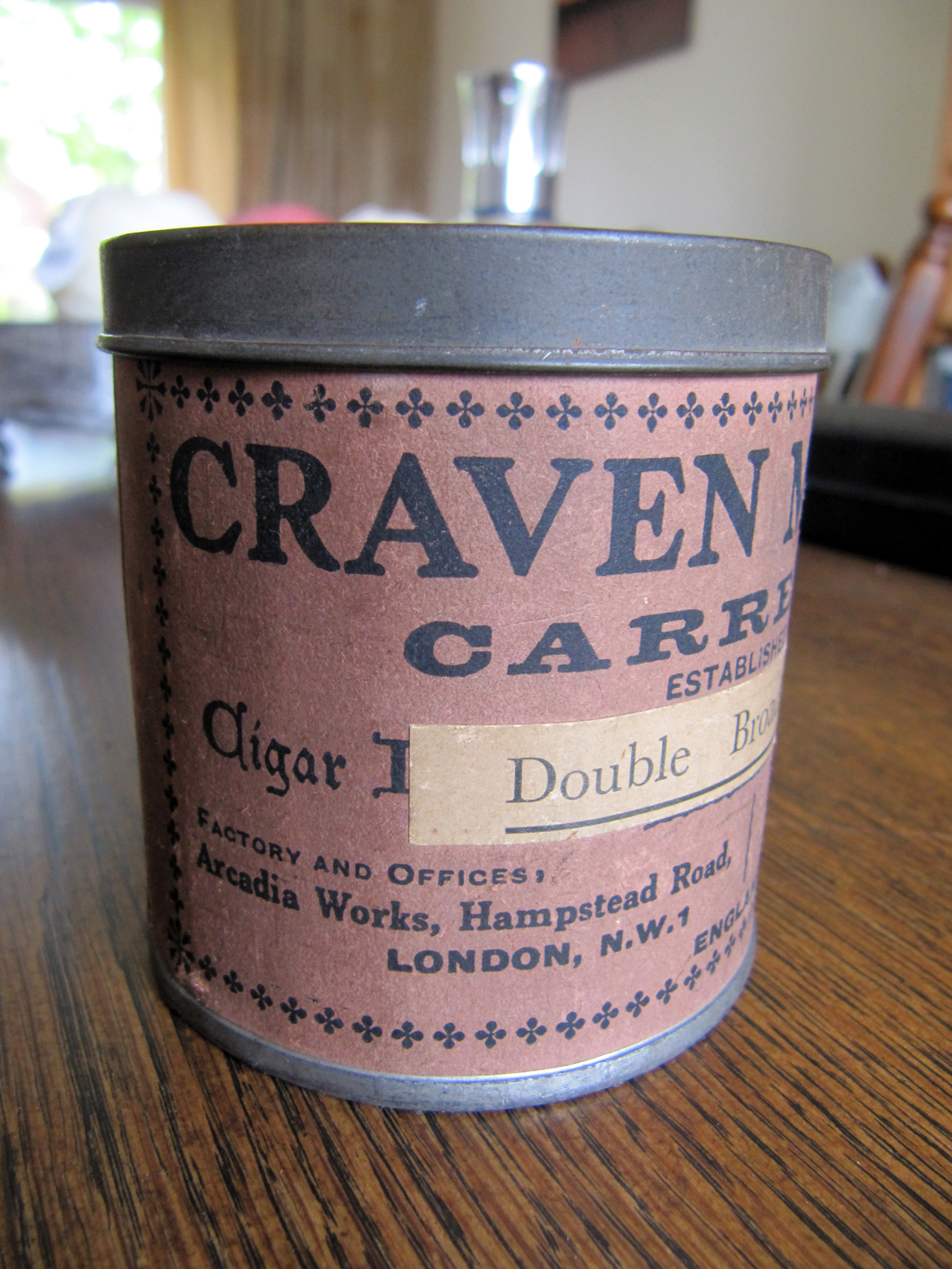Some time ago while browsing on the British ebay I saw an old still full and sealed tin of Carreras’ Craven Mixture. Somewhere in the back of my mind I remembered reading about it. After a quick Google search I knew it. It was the blend famous novelist and author J.M. Barrie called “Arcadia Mixture” in his famous “My Lady Nicotine” book. The ebay tin looked pretty good so I decided to bid on it. To my pleasant surprise I won it for very little money. The lady from who I bought it was somewhat worried when she had send the package: “You are not going to smoke it right? It’s OLD!” I answered “Madam, I have every intention of smoking it!” And so I did.
Craven Mixture originally was made by the Carreras Tobacco Company. The House of Carreras was a tobacco business that was established in London in the 18th century by a nobleman from Spain, Don José Carreras Ferrer. In the early 18th century Carreras began trading in London. This was a time when cigars were increasing in popularity and Don José became a pioneer in his field. However, although business went very well it did not become a major company until his son, Don José Joaquin, began to specialise himself in the blending of tobaccos.
By 1852 Don José Joaquin Carreras had established himself near Leicester Square. In 1853 he was granted the high honour of being the sole supplier of cigars and tobacco to the Spanish Legation (a diplomatic representative office lower than an embassy) in London. Don José’s fame as a skilled tobacco blender soon spread. He produced special blends to suit the individual tastes of the highest members of society. Fashionable and distinguished customers visited his showrooms to select their own tobaccos. One of Don José’s most famous customers was the third Earl of Craven. A special blend, yes you guessed it correctly, Craven Mixture, was created specially for him.
Carreras soon opened another shop. This time in the Arcade in London’s newly developed and fashionable Regent Street W1. Here he was visited by royalty from many countries. Some of Don José’s tobacco brands became world famous. As well as Craven Mixture, you had Guards’ Mixture, Hankey’s Mixture and others. Over one thousand brands of cigar (!) could be bought from Carreras. Together with snuffs, cigarettes, pipes and other tobacco related items. The business remained in the hands of the Carreras family until 1894 when Mr. W J Yapp took control. In 1903 Carreras leadership fell to Bernhard Baron when he and Yapp both became directors.
J. M. Barrie, best known as the creator of Peter Pan, was a valued customer during the 1890’s. When he wrote “My Lady Nicotine” (which was published in 1890) he centred the story around a mythical tobacco called Arcadia Mixture. It did not take long before Carreras realised that the only tobacco Barrie bought was the Craven Mixture. In January 1897 Barrie confirmed to Don José that Arcadia Mixture and Craven Mixture were one and the same. Shortly after that Carreras began using Barrie’s endorsement in his advertising. Craven Mixture sales increased rapidly at home and abroad.
In the stories of Sherlock Holmes the blend also appears. It was Dr. Watson’s favourite pipe tobacco. Holmes recognized it by it’s characteristic fluffy white ash. It was said to be of such extraordinary character and delicacy that it stopped all conversation.
After some very, very successful decades the Baron family (which had held a controlling interest in Carreras since the early 1900’s) decided to sell their shares in 1958 to Rothmans. Carreras Rothmans Ltd. was formed in 1972, when Carreras Limited was used as the vehicle for the merger of various European tobacco interests to form Rothmans International.
Nowadays Craven Mixture is no longer made. Although McClelland re-created the blend: 221b Series, Arcadia. Cornell & Diehl also made a re-creation: 531, Yale Mixture.
Ok, enough history. Let’s go back to the tin I purchased. I date this one to the 1930’s because of the mention of Arcadia Works on the tin (post-1928) and the resemblance to the tins on the advertisements you can see in this post. Besides a little rust the knife-cutter tin looked just fine, the foil below the lid was intact. Still, you can never know how the tobacco in the tin behaved after about 80 years. There can be microscopic holes which let the air out, the inside could be very badly rusted etc.. So a bit nervous I pulled the little knife on the lid away, took a deep breath and placed it on the foil thus penetrating it. To my absolute delight I heard a 3 second long hiss of escaping air and smelled the ancient tobacco. Yessss!!! That meant the tin still was sealed! Quickly I cut away the rest of the foil by turning the lid around. I could not believe the tobacco inside was still moist and springy after all this time. The smell was a bit sour, like a pile of autumn leaves on the earthy ground.
 I grabbed my old patent era Dunhill shell briar prince, filled it up and lit it. I was rewarded with a very smooth smoke and taste. Of course the ingredients had decades to blend inside the tin. The mixture is fairly strong in the nicotine department. After only one third of a bowl I already found myself running to the fridge for some fruit-juice to temper my fast aggravating queasiness.. Identifying the individual elements in this mixture is pretty difficult. As far as I can taste after one bowl this blend contains Syrian latakia. At least, after smoking quite a lot of McClelland Three Oaks Syrian past week I can pretty safely say it is Syrian. Besides the typical smoothness and smokiness of the Syrian dark leaf I also detected Virginias. I do not think a lot of bright Virginias were used since the blend is not really sweet. Orientals I did not detect. The flavour is quite straight, pure, strong and unified. The smoke has a constant and consistent taste and body from start to end.
I grabbed my old patent era Dunhill shell briar prince, filled it up and lit it. I was rewarded with a very smooth smoke and taste. Of course the ingredients had decades to blend inside the tin. The mixture is fairly strong in the nicotine department. After only one third of a bowl I already found myself running to the fridge for some fruit-juice to temper my fast aggravating queasiness.. Identifying the individual elements in this mixture is pretty difficult. As far as I can taste after one bowl this blend contains Syrian latakia. At least, after smoking quite a lot of McClelland Three Oaks Syrian past week I can pretty safely say it is Syrian. Besides the typical smoothness and smokiness of the Syrian dark leaf I also detected Virginias. I do not think a lot of bright Virginias were used since the blend is not really sweet. Orientals I did not detect. The flavour is quite straight, pure, strong and unified. The smoke has a constant and consistent taste and body from start to end.
No one who smokes the Arcadia Mixture would ever attempt to describe its delights. J.M. Barrie. Well, I just did.











